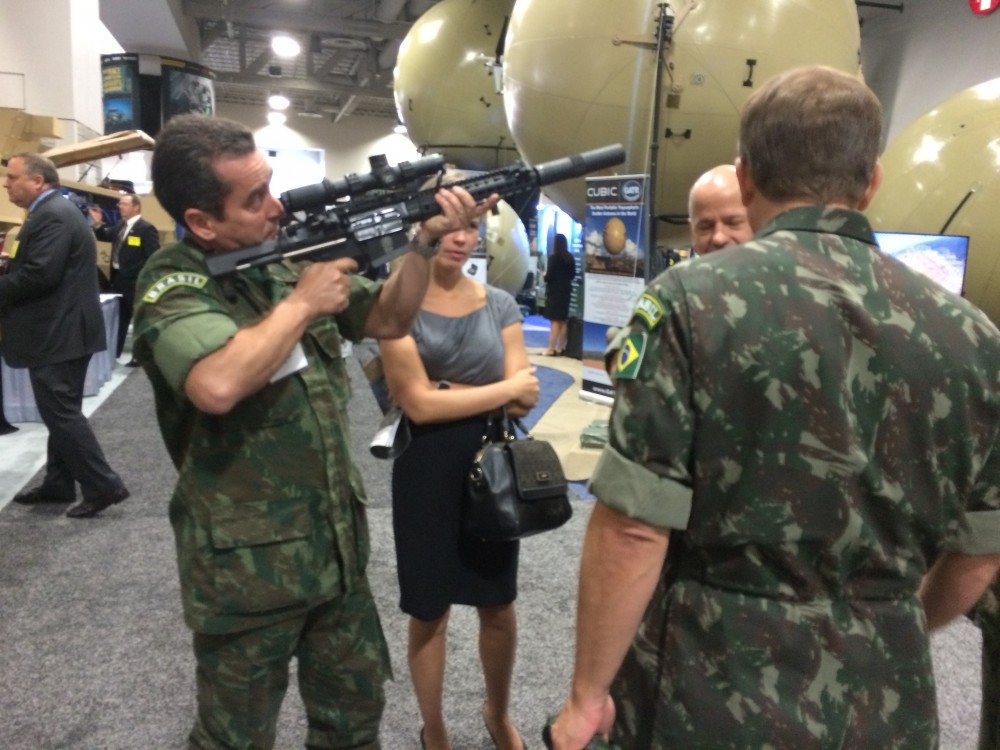To Sell Weapons, Defense Contractors Make War Seem Fun
MILITARISM, 10 Oct 2016
Naomi LaChance – The Intercept

Soldiers from the U.S. Military adjust a 30 mm cannon at the EOS booth at the Association of the United States Army (AUSA) Annual Meeting & Exhibition.
6 Oct 2016 – I’m getting commands to aim and fire. I pull the trigger again and again until I see an explosion. I feel vaguely sick, maybe because my chair shakes every time I pull the trigger, or maybe because the images I’m seeing are blurry.
When I take off my VR headset, a smiling young woman hands me a round token: Distinguished Gunner A14, it says. I’m not exactly the target audience — and neither are the high school boys I saw enjoying the game later.

A visitor plays a VR game at the General Dynamics booth at at the Association of the United States Army (AUSA) Annual Meeting & Exhibition.
Photo: Naomi LaChance for The Intercept
The woman tells me the game is to show just how strong the General Dynamics Stryker 30mm cannon is. I’m at the Association of the United States Army’s annual exposition, Monday to Wednesday at the new, cavernous Washington Convention Center, where in order to score contracts with the Pentagon, defense contractors are making their weapons seem fun.
AUSA features a who’s who of the military-industrial complex, and the extreme excess of money in the industry is evident everywhere.

Bullets from CAV-X, in a display case at the Association of the United States Army (AUSA) Annual Meeting & Exhibition.
Photo: Naomi LaChance for The Intercept
“This is the place to be,” Bill Underwood, client manager at Boeing, told me. [AUSA] “puts you in touch with decision makers.” Boeing would know — they have a lot of contracts with the Pentagon.
There were other video games in addition to General Dynamics’s. I watched Nathan Stoddart, a software engineer, show two congressional staffers a virtual reality game called Project Argus. The game places the character in a battle on an island. There are battleships nearby and a Predator drone overhead. L-3 envisions using the game for planning and post-mission analysis.
The staffers didn’t want to talk to me, but they were clearly having a good time.
DSG Tech showed off its bullets in a glass case like jewelry. “This is the coolest, newest, hottest ammo ever,” said Jon Andre Garberg, founder and CEO of the company. He said that his product is used frequently by the Navy, but they’re hoping to attract the Army as well.
Back at the General Dynamics booth, three high school boys were enjoying the cannon game.
“This is what people do in real life. It’s pretty cool,” said Brian Hoffman after taking off the headset. Hoffman is a senior at Bishop Ireton High School who came to the exposition as part of a school trip.
Many of the displays allow you to interact with the merchandise. I saw soldiers in Brazilian army uniforms picking up machine guns and pointing them at each other, for example.
Honeywell’s VR setup featured a tour of its navigation and sensor systems. “It’s a great way to show capabilities that Honeywell has,” Tom Hart, vice president of Honeywell Defense and Space, told The Intercept. The company is developing virtual windows for windowless armored vehicles.
Australian company Electro-Optic Systems positioned its M230 LF chain gun, so its 30mm cannon was trained on the crowd. Visitors could adjust and aim the weapon toward nearby visitors in real time, watching them on a screen.
“It has a significant jump in lethality,” CEO Warwick Holloway told The Intercept. Holloway said his company focuses on U.S. and Middle East markets, and is trying to use the exposition to sell to the American military.
Boeing had a green screen where visitors could pose next to Boeing products — like a bomb, a missile, or a helicopter. At General Atomics, visitors chatted under a rotating models of the Gray Eagle drone, which was developed as an upgrade to the Predator drone.
This is the best that war is ever going to look. It’s flashy, exciting, and seems to have no downside.
________________________________________
Naomi LaChance – ✉naomi.lachance@theintercept.com
Go to Original – theintercept.com
DISCLAIMER: The statements, views and opinions expressed in pieces republished here are solely those of the authors and do not necessarily represent those of TMS. In accordance with title 17 U.S.C. section 107, this material is distributed without profit to those who have expressed a prior interest in receiving the included information for research and educational purposes. TMS has no affiliation whatsoever with the originator of this article nor is TMS endorsed or sponsored by the originator. “GO TO ORIGINAL” links are provided as a convenience to our readers and allow for verification of authenticity. However, as originating pages are often updated by their originating host sites, the versions posted may not match the versions our readers view when clicking the “GO TO ORIGINAL” links. This site contains copyrighted material the use of which has not always been specifically authorized by the copyright owner. We are making such material available in our efforts to advance understanding of environmental, political, human rights, economic, democracy, scientific, and social justice issues, etc. We believe this constitutes a ‘fair use’ of any such copyrighted material as provided for in section 107 of the US Copyright Law. In accordance with Title 17 U.S.C. Section 107, the material on this site is distributed without profit to those who have expressed a prior interest in receiving the included information for research and educational purposes. For more information go to: http://www.law.cornell.edu/uscode/17/107.shtml. If you wish to use copyrighted material from this site for purposes of your own that go beyond ‘fair use’, you must obtain permission from the copyright owner.
